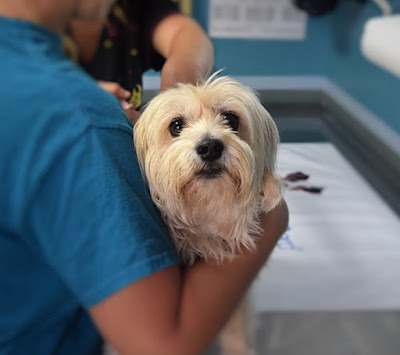What is Diabetes?
Diabetes is a chronic condition that affects humans, dogs, cats, apes, pigs and horses. There are two main types:- Type 1 is an insulin deficiency and the body doesn’t make enough insulin
- Type 2 is more of a resistance to insulin as the body produces enough but it isn’t being used as it should
Read on if you want a more in-depth explanation of the exact process of how insulin works, otherwise, skip down to the section on Pets With a Higher Risk of Developing Diabetes.
How Does The Body Use Insulin?
Basically, the process of how bodies use insulin is as follows: Digested food passes through the intestines and sugars are absorbed from the food and transported to the cells of the intestines. In the cells, the sugar is converted into simple sugars (such as glucose) and then absorbed into the bloodstream.Once in the bloodstream, the sugars circulate throughout the cells and tissues. For the sugars to transfer from the bloodstream into cells, insulin is required. If there is not enough insulin in the bloodstream, the body can’t use the sugars, meaning they stay in the blood and the body can become hyperglycemic.
To rid the body of these excess sugars, it is released in urine, taking lots of water with it. Because the body can’t transfer sugars into the cells and they don’t have enough energy to function properly, the body starts to break down fat and muscles instead, converting them to sugar in the liver.
Pets With a Higher Risk of Developing Diabetes
Certain breeds appear to be more prone to diabetes than others. All sizes of Poodles, Dachshunds, Schnauzers, Cairn Terriers, Australian Terriers, Fox Terriers, Beagles and Samoyeds appear to be the most prone breeds of dogs.In cats, Burmese, Norwegian Forest Cats and Tonkinese are more prone to diabetes than other breeds.
Also, just like humans, overweight pets are more at risk of developing diabetes. Pets with chronic pancreatitis (inflammation of the pancreas) are also at greater risk of developing diabetes. And just like pregnant humans, pregnant pets can also develop gestational diabetes, as can female dogs when they are on heat. Other risk factors include long term use of steroids, certain diseases such as Cushing’s or other autoimmune diseases and some viruses.
Dogs between the ages of 4 and 14 are more prone to developing diabetes and it is commonly diagnosed in dogs when they are between the ages of 7 and 10. Females that have not been spayed are twice as likely as males to develop diabetes.
In cats, they are more likely to develop diabetes if male, and once they are over 6 years of age.
Signs & Symptoms of Diabetes
In the early stages of diabetes in pets, they may not be showing any symptoms and it is often only discovered that they have diabetes through regular blood or urine tests that detect the excess levels of sugar.If your pet has had very high sugar levels for a long time and your pet has become very unwell due to the excess levels of sugar in the blood and urine, they may require hospitalisation to stabilise their sugar levels. This is often only for a couple of days while the vet provides fluids and medication to your pet.
If your pet has been very sick with diabetes for a long time, it can take longer for their sugar levels to be stabilised and they may be required to stay at the vets for much longer.
Some common symptoms of the early stages of diabetes in pets include:
- Excessive thirst
- Excessive urination – your pet may be having accidents around the house or wanting to go outside all of the time
- Weight loss
- Increased appetite but no weight gain
- Increased recurrent infections of the skin, kidneys or bladder
- High liver enzymes or electrolyte imbalances – detected in blood and urine tests
- Loss of appetite
- Lack of energy
- Depression
- Vomiting
- Cataracts and blindness
- Enlarged liver
- Seizures
- Kidney failure
- Ketoacidosis
What is Hyperglycemia?
Hyperglycemia is the term used to describe when there are high levels of sugar in the blood.Hyper = excessively above normal + glycemia = glucose in blood.
Your vet will be able to tell you the exact levels your pets blood sugar needs to reach for them to be considered hyperglycemic but a healthy blood glucose range in a dog is usually between 75-120mg.
Your pet can become hyperglycemic if they eat human food (particularly foods that are high in sugar), they miss an insulin dose, if they become overexcited or are under stress such as during a vet visit or after surgery.
Signs your pet is hyperglycemic includes the early-stage symptoms of diabetes such as:
- Excessive thirst
- Excessive urination – your pet may be having accidents around the house or wanting to go outside all of the time
- Weight loss
- Increased appetite but no weight gain
What is Ketoacidosis?
Ketoacidosis is a life-threatening, acute condition that occurs when the blood sugar levels get so high that the body has started to draw energy from fat sources in the body. In this process, the body creates ketones which make the body more acidic and which disrupts the fluid and electrolyte balance. This can lead to abnormal heart rhythms and altered muscle function.As well as low insulin levels, ketoacidosis can be triggered by stress and stressful incidents such as surgery, an infection, fasting and other underlying health issues.
Signs your pet has ketoacidosis include:
- Rapid breathing
- Dehydration
- Lethargy
- Vomiting
- Sweet-smelling or acetone breath
If your pet has been diagnosed with diabetes, you may also have been advised by your vet to keep ketone sticks on hand to test for ketoacidosis. If the test is positive for ketones, take your pet immediately to your vet. Ketoacidosis is a life-threatening condition.
What is Hypoglycemia?
Hypoglycemia is the term used to describe low blood sugar levels.Hypo = under or below normal + glycemia = glucose in blood.
An easy way to remember the difference between hyper and hypo is to remember the rhyme "hypo means low".
Your pet can become hypoglycemic if they are given too much insulin, if they don't eat enough or if they vomit shortly after eating, if there is a change to the amount of food they eat or they are exercised too much.
Signs your pet is hypoglycemic includes:
- Lethargy or restlessness
- Behavioural changes such as anxiety
- Muscle twitching or weakness
- Seizures
Diagnosing Diabetes
Diabetes can only be diagnosed by a veterinarian as it requires a full examination and the taking and testing of blood and urine samples. Your vet will check the blood and urine of your pet for high sugar levels and will compare any physical symptoms that have appeared when considering a diagnosis of diabetes in your pet.If your pet has been unwell with diabetes for some time, they may need to remain at your vet for fluids and close monitoring for a few days. Sicker pets may need to stay even longer while their sugar levels are brought under control.
Treating Diabetes
There are a number of factors that play a role in the treatment of diabetes in pets.Your veterinarian will likely prescribe insulin for your pet. Unfortunately, insulin can only be given as an injection, but don’t worry, the needles are tiny, and your vet will teach you how to give your pet insulin safely. You should never change your pets’ dose of insulin without your vet’s advice.
Diet is another important part of managing diabetes in pets. If your pet is overweight, you will need to restrict their food intake to help them lose those extra kilos. Sticking to a strict feeding time and amount is also important, as the amount of insulin you give your pet is calculated based on the amount of food they eat.
It may be worth investing in a small set of kitchen scales to ensure you are accurately feeding your pet the correct amount every time. Insulin is commonly given twice per day so you will typically feed your pet twice a day as well.
There are also a variety of special foods on the market that are designed for pets with diabetes. In dogs, it has been found that a diet high in fibre and low in carbs is ideal for those with diabetes. In cats, a high protein, high fibre and low carb diet is ideal.
You must also maintain a consistent amount of exercise for your pet. If you suddenly increase or decrease the amount of exercise your pet does, your pet may suddenly have too much insulin or not enough insulin in their body to process sugars and they could become ill. Exercise is also helpful in keeping off those extra kilos and helping those pets that are a little pudgy to return to a healthy weight range.
And don’t forget that cats need exercise just as much as dogs! You can encourage your cat to be more active by using a toy that gets them chasing and leaping. Toys with a long stick and a toy at the end of a long piece of elastic string are a favourite of many cats, but you will know what toys really get your cat moving!
Managing diabetes
Diabetes is not a death sentence for your pet and can be managed through regular vet visits and by following a strict diet and medication regime.It is advised that you keep good records of your pets’ food and water intake, urine output and record every time you give your pet a dose of insulin to avoid accidentally double dosing.
Recording how much your pet eats is necessary to ensure your vet is prescribing the correct dose of insulin, and recording your pet’s intake and output of fluids is a good way to keep an eye on their health. If you aren’t sure how much your pet drinks every day, start the day off with a full bowl of a specific amount of water. After a certain amount of time (12 or 24 hours), measure any remaining water.
You can estimate how much water your dog should be drinking by multiplying their body weight by 60mL. This is roughly how much water your pet should be drinking in a 24-hour period, but your vet will advise on the ideal amount for your pet.
It is important that you closely follow your pet’s diabetes management plan that has been developed by their veterinarian. Any deviation in the amounts of food, exercise or medication you pet has can have life-threatening consequences.
Untreated Diabetes
If left untreated, diabetes can cause the following problems in your pet:- The development of cataracts leading to blindness
- Increasing weakness, especially in the legs due to neuropathy (a disease of the nerves)
- Malnutrition
- Dehydration
- Ketoacidosis
- Death
Conclusion
Caring for a diabetic pet requires a considerable ongoing personal and financial commitment from you, their owner. The prognosis for a pet diagnosed with diabetes is very good if you are committed to the ongoing monitoring and treatment of their condition.If you are faced with caring for a pet with diabetes, you should take the time to ask your veterinarian lots of questions and talk with your family about whether you feel you are capable of taking on the responsibility of caring for a diabetic pet.
















0 comments